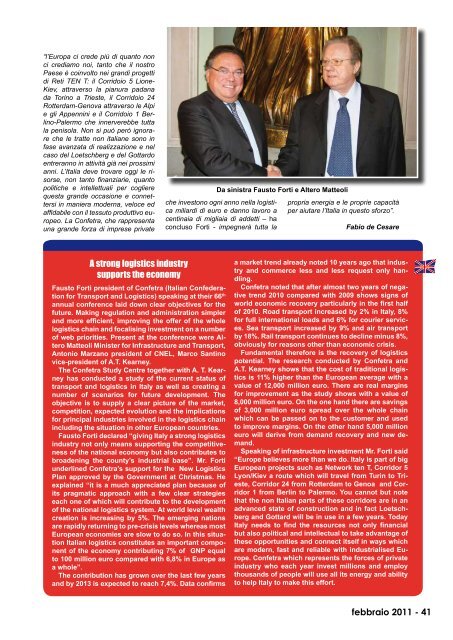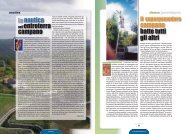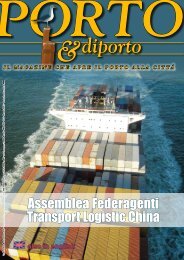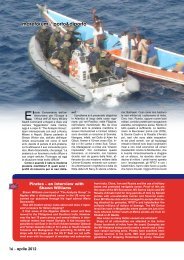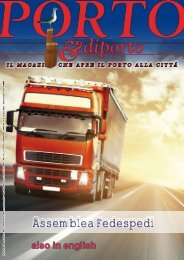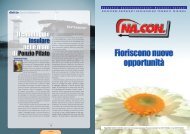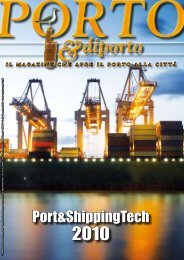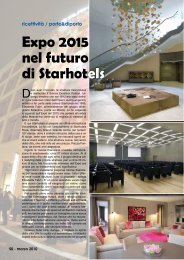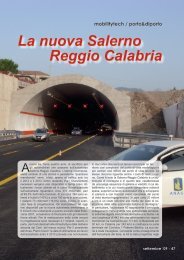You also want an ePaper? Increase the reach of your titles
YUMPU automatically turns print PDFs into web optimized ePapers that Google loves.
“l’Europa ci crede più di quanto nonci crediamo noi, tanto che il nostroPaese è coinvolto nei grandi progettidi Reti TEN T: il Corridoio 5 Lione-Kiev, attraverso la pianura padanada Torino a Trieste, il Corridoio 24Rotterdam-Genova attraverso le Alpie gli Appennini e il Corridoio 1 Berlino-Palermoche innerverebbe tuttala penisola. Non si può però ignorareche le tratte non italiane sono infase avanzata di realizzazione e nelcaso del Loetschberg e del Gottardoentreranno in attività già nei prossimianni. L’Italia deve trovare oggi le risorse,non tanto finanziarie, quantopolitiche e intellettuali per coglierequesta grande occasione e connettersiin maniera moderna, veloce edaffidabile con il tessuto produttivo europeo.La Confetra, che rappresentauna grande forza di imprese privateDa sinistra Fausto Forti e Altero Matteoliche investono ogni anno nella logisticamiliardi di euro e danno lavoro acentinaia di migliaia di addetti – haconcluso Forti - impegnerà tutta lapropria energia e le proprie capacitàper aiutare l’Italia in questo sforzo”.Fabio de CesareA strong logistics industrysupports the economyFausto Forti president of Confetra (Italian Confederationfor Transport and Logistics) speaking at their 66 thannual conference laid down clear objectives for thefuture. Making regulation and administration simplerand more efficient, improving the offer of the wholelogistics chain and focalising investment on a numberof web priorities. Present at the conference were AlteroMatteoli Minister for Infrastructure and Transport,Antonio Marzano president of CNEL, Marco Santinovice-president of A.T. Kearney.The Confetra Study Centre together with A. T. Kearneyhas conducted a study of the current status oftransport and logistics in Italy as well as creating anumber of scenarios for future development. Theobjective is to supply a clear picture of the market,competition, expected evolution and the implicationsfor principal industries involved in the logistics chainincluding the situation in other European countries.Fausto Forti declared “giving Italy a strong logisticsindustry not only means supporting the competitivenessof the national economy but also contributes tobroadening the county’s industrial base”. Mr. Fortiunderlined Confetra’s support for the New LogisticsPlan approved by the Government at Christmas. Heexplained “it is a much appreciated plan because ofits pragmatic approach with a few clear strategieseach one of which will contribute to the developmentof the national logistics system. At world level wealthcreation is increasing by 5%. The emerging nationsare rapidly returning to pre-crisis levels whereas mostEuropean economies are slow to do so. In this situationItalian logistics constitutes an important componentof the economy contributing 7% of GNP equalto 100 million euro compared with 6,8% in Europe asa whole”.The contribution has grown over the last few yearsand by 2013 is expected to reach 7,4%. Data confirmsa market trend already noted 10 years ago that industryand commerce less and less request only handling.Confetra noted that after almost two years of negativetrend 2010 compared with 2009 shows signs ofworld economic recovery particularly in the first halfof 2010. Road transport increased by 2% in Italy, 8%for full international loads and 6% for courier services.Sea transport increased by 9% and air transportby 18%. Rail transport continues to decline minus 8%,obviously for reasons other than economic crisis.Fundamental therefore is the recovery of logisticspotential. The research conducted by Confetra andA.T. Kearney shows that the cost of traditional logisticsis 11% higher than the European average with avalue of 12,000 million euro. There are real marginsfor improvement as the study shows with a value of8,000 million euro. On the one hand there are savingsof 3,000 million euro spread over the whole chainwhich can be passed on to the customer and usedto improve margins. On the other hand 5,000 millioneuro will derive from demand recovery and new demand.Speaking of infrastructure investment Mr. Forti said“Europe believes more than we do. Italy is part of bigEuropean projects such as Network ten T, Corridor 5Lyon/Kiev a route which will travel from Turin to Trieste,Corridor 24 from Rotterdam to Genoa and Corridor1 from Berlin to Palermo. You cannot but notethat the non Italian parts of these corridors are in anadvanced state of construction and in fact Loetschbergand Gottard will be in use in a few years. TodayItaly needs to find the resources not only financialbut also political and intellectual to take advantage ofthese opportunities and connect itself in ways whichare modern, fast and reliable with industrialised Europe.Confetra which represents the forces of privateindustry who each year invest millions and employthousands of people will use all its energy and abilityto help Italy to make this effort.<strong>febbraio</strong> 2011 - 41


